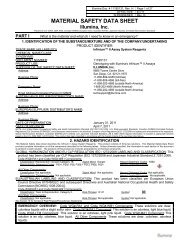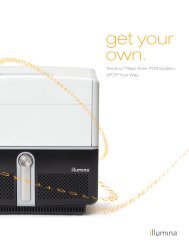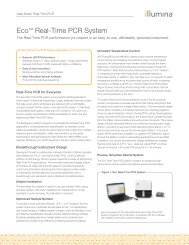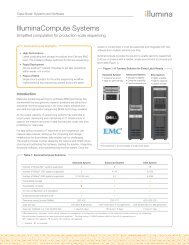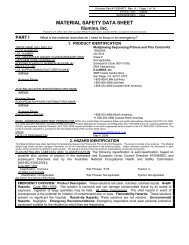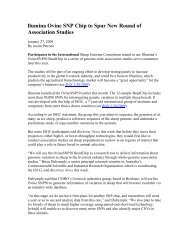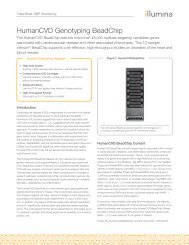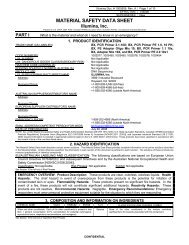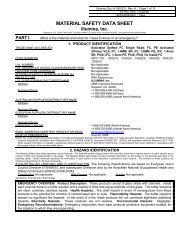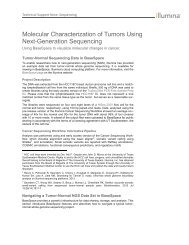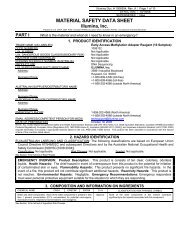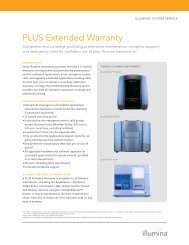Analysis of the Medaka genome - Illumina
Analysis of the Medaka genome - Illumina
Analysis of the Medaka genome - Illumina
You also want an ePaper? Increase the reach of your titles
YUMPU automatically turns print PDFs into web optimized ePapers that Google loves.
Analysing <strong>genome</strong>s and transcriptomes using<br />
<strong>Illumina</strong> sequencing<br />
Dr. Heinz Himmelbauer<br />
Centre for Genomic Regulation (CRG)<br />
Ultrasequencing Unit<br />
Barcelona<br />
From Whole Genome to Whole Solution, Disease <strong>Analysis</strong> Tools for <strong>the</strong> Next Generation
The Sequencing Revolution<br />
High-Throughput Sequencing<br />
2000<br />
High-Throughput Sequencing<br />
2009<br />
Image credit: U.S. Department <strong>of</strong> Energy, JGI<br />
96 sequences per hour 2.6 million sequences per hour<br />
From Whole Genome to Whole Solution, Disease <strong>Analysis</strong> Tools for <strong>the</strong> Next Generation
Next generation sequencing platforms<br />
Applications<br />
• mRNA-Seq: expression pr<strong>of</strong>iling, transcript discovery<br />
• Small RNAs (miRNAs)<br />
• ChIP-Seq, RIP-Seq<br />
• DNA methylation<br />
• Re-sequencing, haplotyping (SNPs and structural variation)<br />
• De novo sequencing<br />
From Whole Genome to Whole Solution, Disease <strong>Analysis</strong> Tools for <strong>the</strong> Next Generation
Sequencing platforms<br />
Technology Year Read length Chemistry Template<br />
(nt)<br />
amplification<br />
Sanger 1977 1000 SBS cloning/PCR<br />
454 2005 250-500 Pyro PCR<br />
Solexa 2006 36-75 SBS PCR<br />
SOLiD 2007 35 Ligation PCR<br />
Helicos 2008 30 SBS no amplification<br />
PacBio 2010 ? 1000 SBS no amplification<br />
VisiGen 2009 ? 1000 SBS no amplification<br />
Oxford Nanopore ? ? Elco no amplification<br />
SBS = Sequencing by Syn<strong>the</strong>sis<br />
Pyro = Pyrosequencing<br />
Ligation = Sequencing by ligation assays<br />
Elco = Electrochemical detection<br />
From Whole Genome to Whole Solution, Disease <strong>Analysis</strong> Tools for <strong>the</strong> Next Generation
<strong>Illumina</strong>/Solexa technology<br />
Library preparation<br />
Cluster generation<br />
Cycle sequencing<br />
Solexa GA II run:<br />
- 45 hours<br />
- 1 TB image data<br />
- 10 x 8 mio. 36-50 nt<br />
- up to 2.9 Gbp<br />
Base calling<br />
From Whole Genome to Whole Solution, Disease <strong>Analysis</strong> Tools for <strong>the</strong> Next Generation
Summary <strong>of</strong> Solexa properties<br />
Reads are short (36 nt), but get progessively longer (50 nt, 75 nt)<br />
8 samples can be sequenced in parallel<br />
Protocols in use at <strong>the</strong> CRG:<br />
• Shotgun sequencing (genomic DNA, cDNA, ChIP-Seq, RIP-Seq)<br />
• mRNA-Seq<br />
• Indexed RNA-Seq<br />
• Small RNA (miRNAs) identification and pr<strong>of</strong>iling<br />
• Gene expression pr<strong>of</strong>iling (Tag sequencing, similar to SAGE)<br />
• Paired end sequencing (long and short paired ends)<br />
Advantages<br />
• Millions <strong>of</strong> reads from your sample<br />
• Relatively cheap<br />
Disadvantages<br />
• Millions <strong>of</strong> reads from your sample<br />
• Some biases, poorly understood<br />
• Sequencing errors (but <strong>Illumina</strong> improves)<br />
• Demands on IT infrastructure (data processing, analysis, backup)<br />
From Whole Genome to Whole Solution, Disease <strong>Analysis</strong> Tools for <strong>the</strong> Next Generation
<strong>Illumina</strong> GA II workflow<br />
4 images/tile per cycle<br />
~23 GB per cycle<br />
~800GB for 36 cycles<br />
1 intensity file per tile<br />
~1.4 GB per cycle<br />
~ 50 GB for 36 cycles<br />
<strong>Illumina</strong><br />
Genome<br />
Analyzer<br />
1 flowcell<br />
8 lanes<br />
Run summary<br />
Error report<br />
Alignment coordinates<br />
Several files per lane<br />
~40 GB for 36 cycles<br />
tiff<br />
tiff<br />
tiff<br />
tiff<br />
tiff<br />
tiff<br />
tiff<br />
tiff<br />
tiff<br />
tiff<br />
tiff<br />
tiff<br />
tiff<br />
Gerald: Aligns<br />
sequences with<br />
Eland<br />
Int<br />
Int<br />
Int<br />
Int<br />
Firecrest: quantifies<br />
<strong>the</strong> intensity levels<br />
in images.<br />
seq<br />
seq<br />
seq<br />
seq<br />
seq<br />
seq<br />
seq<br />
seq<br />
seq<br />
seq<br />
seq<br />
Int<br />
Int<br />
Int<br />
seq<br />
seq<br />
Int<br />
Int<br />
Int<br />
Int<br />
Int<br />
Int<br />
Bustard: calls<br />
bases by<br />
comparing<br />
intensity levels<br />
1 sequence file per tile<br />
~1.1 GB per cycle<br />
~40 GB for 36 cycles<br />
From Whole Genome to Whole Solution, Disease <strong>Analysis</strong> Tools for <strong>the</strong> Next Generation
Images taken by GA II<br />
Computing Infrastructure<br />
Images written to Dell<br />
Precision Workstation<br />
(2 Dual-cores 2.66 Ghz, 3GB<br />
RAM, 1TB RAID)<br />
Images copied to HP Proliant IPAR<br />
(2 Quad cores 3 GHz, 16GB RAM,<br />
4TB RAID). Intensity files created<br />
'real-time'.<br />
Images<br />
Images<br />
Images<br />
Intensity files copied to analysis server<br />
Intensity files<br />
Data stored on 1TB FATA discs<br />
(17TB RAID). Images written to<br />
tape and deleted.<br />
Base-calling, Gerald and post-analysis<br />
performed on HP Proliant analysis servers<br />
(2 or 4 Quad-cores ~3.2 GHz, 32GB RAM)<br />
From Whole Genome to Whole Solution, Disease <strong>Analysis</strong> Tools for <strong>the</strong> Next Generation
Solexa/<strong>Illumina</strong> sequencing at <strong>the</strong> CRG<br />
Set up <strong>of</strong> GA I<br />
Upgrade to GA II<br />
Set up <strong>of</strong> 2nd GA II<br />
60<br />
Number <strong>of</strong> flowcell lanes used<br />
50<br />
40<br />
30<br />
20<br />
10<br />
0<br />
02/2008 04/2008 06/2008 08/2008 10/2008 12/2008 02/2009 04/2009<br />
01/2008 03/2008 05/2008 07/2008 09/2008 11/2008 01/2009 03/2009 05/2009<br />
Month<br />
From Whole Genome to Whole Solution, Disease <strong>Analysis</strong> Tools for <strong>the</strong> Next Generation
Open-source LIMS for Solexa run management<br />
Dadabik (database interface creator) web browser user interface<br />
Dadabik web browser admin interface<br />
SQL database<br />
Automated scripts which update <strong>the</strong> database and send<br />
notification e-mails<br />
Requires Dadabik, SQL, Apache, PHP, and a Linux web server<br />
From Whole Genome to Whole Solution, Disease <strong>Analysis</strong> Tools for <strong>the</strong> Next Generation
Open-source LIMS for Solexa run management<br />
From Whole Genome to Whole Solution, Disease <strong>Analysis</strong> Tools for <strong>the</strong> Next Generation
Cluster densities<br />
150.000 clusters per tile recommended<br />
100 tiles per lane, 15 million raw sequences per lane<br />
Number <strong>of</strong> usable sequences not affected by fur<strong>the</strong>r density<br />
increase<br />
Improved s<strong>of</strong>tware (<strong>Illumina</strong> pipeline 1.3.2 and 1.4.0) to deal<br />
with merged clusters<br />
From Whole Genome to Whole Solution, Disease <strong>Analysis</strong> Tools for <strong>the</strong> Next Generation
Solexa sequencing:<br />
Many millions <strong>of</strong> <strong>of</strong> short reads<br />
seq: AATTATGCCTTGATGTGTGGGCGATCGCTTCACATA<br />
seq: ATGAAAAAATCGCGCTAGATTTATTGCCGGTGATTT<br />
seq: AAACTCAAATTCCTATTATATCAAACAATTTTTATA<br />
seq: AACTGACGGAGTTCCTTTTTGGTCGCTCCGCTTTGC<br />
seq: AGCTTGAATGCCCCTAGTGCTTTTATTTTATCGCGC<br />
seq: ATCCGCATAAAAGCATTTATCCATGTGGGTAAGCTG<br />
seq: ATTGGGGGTGGGATTAGCGCTTGCACTAGATTTTGG<br />
seq: AATAAAACCCCATGCGTTTTACTTTTTCTTGGGCGT<br />
seq: AGCAAAATAAACCAATCATCTTAAGCCAGCAAAGCA<br />
seq: GCTCTTTTGCACGATAAATTTCACCGCTTCTTTATG<br />
seq: AAAAGCGCAATTGAAAGACGATTTACGCCAATTGAG<br />
seq: AGCTTACCCTCTTTATCATGGTAAGTGAAAGGGGGG<br />
seq: GTGGTCAATATTTTGGGGTTTTTTAACATTAAATTT<br />
seq: GGGTTTAAAGCAGTCTTTTTTATAAAAAAGTGATTT<br />
seq: AACAACAAGCTCTCTGTGGGGCTTTTTGGCGGTATC<br />
seq: AGGGATCGTTTTTGCTCACTAACTCGCCCTTTGGCT<br />
seq: GTGATTAAAATGGGGCGCACCCAGCTTCAAGACGCT<br />
seq: ATGAAGCTTTGTCGCTTTGCTTAGTTATAGAGAGTT<br />
seq: GGGTGGTAGGAGTGTGGAGCTAGTAGAGGCTGTGGT<br />
seq: AATTTGGAATAAGTAGAGATAAGTCGTTTAGTATCC<br />
seq: GAGTTTTAAAGTGTCTAGCCCATAAGAAGAAAAAGT<br />
[...]<br />
From Whole Genome to Whole Solution, Disease <strong>Analysis</strong> Tools for <strong>the</strong> Next Generation
<strong>Analysis</strong> <strong>of</strong> Solexa data<br />
Comparison with reference sequence (not possible with de novo<br />
sequencing)<br />
• Genome sequence<br />
• Transcripts or gene predictions<br />
• Selected data sets (e.g. miRNA sequences)<br />
Positioning Solexa reads on <strong>the</strong> reference <strong>genome</strong> by alignment<br />
• No match<br />
• Match at exactly one position<br />
• Match at more than one position<br />
Mostly only reads with exactly one match in <strong>the</strong> reference<br />
sequence are considered for downstream analysis<br />
Fast algorithms required<br />
From Whole Genome to Whole Solution, Disease <strong>Analysis</strong> Tools for <strong>the</strong> Next Generation
Exemplary data (GA I)<br />
Postioning 12.3 million reads on <strong>the</strong> Helicobacter acinonychis<br />
reference <strong>genome</strong><br />
Up to two mismatches permitted<br />
From Whole Genome to Whole Solution, Disease <strong>Analysis</strong> Tools for <strong>the</strong> Next Generation
S<strong>of</strong>tware to align reads against a reference <strong>genome</strong><br />
Programs differ by: Speed, sensitivity, mismatch tolerance, permitted read<br />
length<br />
Eland (<strong>Illumina</strong>)<br />
• - 2 mismatches in alignment tolerated, no Indels<br />
• - Reads need to have identical lengths<br />
• - Read lengths up to 32 nt<br />
• + Very fast<br />
SeqMap (Jiang, Wong, Bioinformatics, 2008)<br />
• + Tolerates up to 5 mismatches and Indels<br />
• + Different read lengths <strong>of</strong> input sequences is possible<br />
• + Reads may exceed lengths <strong>of</strong> 32 nt<br />
• - Slow<br />
Soap (Li et al., Bioinformatics, 2008)<br />
• + Tolerates up to 5 mismatches and Indels<br />
• - Reads should have similar lengths<br />
• + Read lengths up to 60 nt<br />
• + Fast for entire <strong>genome</strong>s, demanding on hardware<br />
From Whole Genome to Whole Solution, Disease <strong>Analysis</strong> Tools for <strong>the</strong> Next Generation
Solexa resequencing<br />
Alignment against reference <strong>genome</strong><br />
Estimation <strong>of</strong> sequencing error rate<br />
Discovery <strong>of</strong> biologically relevant sequence differences<br />
Discovery <strong>of</strong> variation within a species, by inter-strain<br />
comparisons<br />
From Whole Genome to Whole Solution, Disease <strong>Analysis</strong> Tools for <strong>the</strong> Next Generation
De novo <strong>genome</strong> assembly from Solexa data? YES !<br />
Input data: 12.3 million reads (32 nt) from Helicobacter<br />
acinonychis str. Sheeba (1.6 Mbp)<br />
Previously sequenced with Sanger technology (Eppinger et al.,<br />
2006)<br />
Identical DNA preparations used<br />
Reads Contigs NotMatched Mean Len Max Len N50 N80 Seq Cov<br />
a Q >20 1174569 1330 5 1157 10866 2257 1015 97,39%<br />
Q >25 1098233 1379 5 1110 13684 2232 958 97,16%<br />
Q >30 1034034 1628 4 937 13673 1893 772 96,49%<br />
Q >35 978900 1967 4 773 13020 1558 597 96,33%<br />
b merged 932 5 1603 18577 3476 1364 95,21%<br />
c all merged 937 1636 18854 3659 1501 97,70%<br />
d contig overlap >5 bp 228 6762 62478 19890 8012 97,70%<br />
contigs<br />
N50<br />
size<br />
N80<br />
size<br />
0<br />
10 20 30 40 50 60 70 80 90<br />
100 %<br />
From Whole Genome to Whole Solution, Disease <strong>Analysis</strong> Tools for <strong>the</strong> Next Generation
De novo <strong>genome</strong> assembly from Solexa data? YES !<br />
Genome Research, June 2009<br />
From Whole Genome to Whole Solution, Disease <strong>Analysis</strong> Tools for <strong>the</strong> Next Generation
Acknowledgements<br />
CRG - Ultrasequencing Unit<br />
Lab:<br />
Ana Vivancos<br />
Ester Castillo<br />
Anna Menoyo<br />
Maik Zehnsdorf<br />
Bioinformatics:<br />
Robert K<strong>of</strong>ler<br />
Juliane Dohm<br />
Matt Ingham<br />
Debayan Datta<br />
André Minoche<br />
Cooperations<br />
CRG – Systems Biology Program<br />
Marc Güell<br />
Luis Serrano<br />
CRG- Genes and Disease Program<br />
Eulàlia Martí<br />
Universitat Autonoma de Barcelona<br />
Miguel Pérez-Enciso<br />
Mònica Bayés<br />
From Whole Genome to Whole Solution, Disease <strong>Analysis</strong> Tools for <strong>the</strong> Next Generation



